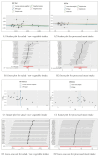Dietary factors and risk for endometriosis: a Mendelian randomization analysis
- PMID: 40624721
- PMCID: PMC12236032
- DOI: 10.1186/s12986-025-00970-9
Dietary factors and risk for endometriosis: a Mendelian randomization analysis
Abstract
Aims: Observational studies have reported an association between dietary factors and endometriosis, but the causality remains unknown. The study aimed to investigate the potential causal association between dietary factors and endometriosis using Mendelian randomization (MR).
Methods: We performed a two-sample MR analysis to investigate the effects of 18 diet-related exposure factors (alcoholic drinks per week, alcohol intake frequency, processed meat intake, poultry intake, beef intake, non-oily fish intake, oily fish intake, pork intake, lamb/mutton intake, bread intake, cheese intake, cooked vegetable intake, tea intake, fresh fruit intake, cereal intake, salad/raw vegetable intake, coffee intake, dried fruit intake) on the risk of endometriosis using summary statistics from the genome-wide association study (GWAS). The inverse variance weighted (IVW) method was used to deduce the causal association between dietary factors and endometriosis, and sensitivity analyses were further performed.
Results: Processed meat intake (OR = 0.550; 95%CI:0.314-0.965; p = 0.037) and salad / raw vegetable intake (OR = 0.346; 95%CI:0.127-0.943; p = 0.038) were discovered as protective factors for endometriosis. Heterogeneity test revealed no significant heterogeneity (processed meat intake: pIVW=0.607, pMR-Egger=0.548; salad / raw vegetable intake: pIVW=0.678, pMR-Egger=0.620). MR-Egger regression test didn't support any evidence for horizontal pleiotropy (processed meat intake: p for intercept = 0.865; salad / raw vegetable intake: p for intercept = 0.725). No causal relationship was found between other dietary intakes and endometriosis.
Conclusion: These findings suggest that processed meat intake and salad/raw vegetable intake are associated with a decreased risk of endometriosis, but further investigation is required.
Keywords: Causal association; Dietary intake; Endometriosis; Mendelian randomization; Processed meat intake; Salad/raw vegetable intake.
© 2025. The Author(s).
Conflict of interest statement
Declarations. Consent for publication: Not Applicable. Competing interests: The authors declare no competing interests. Publisher’s note: All claims expressed in this article are solely those of the authors and do not necessarily represent those of their affiliated organizations, or those of the publisher, the editors and the reviewers. Any product that may be evaluated in this article, or claim that may be made by its manufacturer, is not guaranteed or endorsed by the publisher. Ethics approval and consent to participate: Ethical approval was not needed for this current study because it is a secondary analysis of previously published data. Informed consent: For this type of article, informed consent is not required.
Figures




Similar articles
-
Causal associations between dietary factors and colorectal cancer risk: a Mendelian randomization study.Front Nutr. 2024 May 1;11:1388732. doi: 10.3389/fnut.2024.1388732. eCollection 2024. Front Nutr. 2024. PMID: 38751740 Free PMC article.
-
Causal association between dietary factors and chronic kidney disease: a Mendelian randomisation study.Br J Nutr. 2025 Apr 28;133(8):1115-1123. doi: 10.1017/S0007114525000765. Epub 2025 Apr 4. Br J Nutr. 2025. PMID: 40181604
-
Genetically predicted the causal association between serum mineral elements with immune thrombocytopenia and Henoch-Schonlein purpura: a bidirectional two-sample Mendelian randomization analysis.Thromb J. 2025 Jun 16;23(1):65. doi: 10.1186/s12959-025-00756-2. Thromb J. 2025. PMID: 40524203 Free PMC article.
-
Selenium for preventing cancer.Cochrane Database Syst Rev. 2018 Jan 29;1(1):CD005195. doi: 10.1002/14651858.CD005195.pub4. Cochrane Database Syst Rev. 2018. PMID: 29376219 Free PMC article.
-
Blood biomarkers for the non-invasive diagnosis of endometriosis.Cochrane Database Syst Rev. 2016 May 1;2016(5):CD012179. doi: 10.1002/14651858.CD012179. Cochrane Database Syst Rev. 2016. PMID: 27132058 Free PMC article.
References
-
- Rowlands IJ, Abbott JA, Montgomery GW, et al. Prevalence and incidence of endometriosis in Australian women: a data linkage cohort study. BJOG: Int J Obstet Gynecol. 2021;128(4):657–65. - PubMed
-
- Saunders PTK, Horne AW. Endometriosis: etiology, pathobiology, and therapeutic prospects. Cell. 2021;184(11):2807–24. - PubMed
Grants and funding
LinkOut - more resources
Full Text Sources

